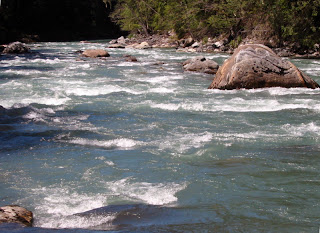In the early days of modern-day river running in the state of Washington, when white water rafting was still relegated to the easier stretches of
accessible Class I-III rapids found on the Skagit,
Suiattle and lower portions of the Stillaguamish, only intrepid kayakers chose to trek to Darrington, Washington, to dip their paddles in the milky green waters of the Sauk River.
At the start of the 1970s, the only commercial rafting company operating in the state rowed their guests down the river in rafts that needed bailing after every set of waves to keep them from getting too unwieldy from thousands of pounds of river water as ballast. The brightly colored orange Rogue inflatables this company used were manufactured from incredibly durable material but this also added to their unwieldiness. In addition, they were lengthy and not well-suited to the boulder-clogged channels that were common on the glacial-fed Sauk River. To top it all off, the Sauk River access points were primitive with no paved road access. The shuttle road on either side of the river was ten miles of potholes and ruts.
As a result, kayakers alone enjoyed the scenic splendors, white water challenges and remote beauty of the Sauk without being intruded upon by packs of commercial guests.
By the time Orion came into existence in 1978, there was a movement afoot to include the Skagit and its tributaries, the Suiattle, Cascade and Sauk, in the federally designated Wild and Scenic River system. River runners familiar with the Sauk - kayakers specifically - lobbied hard to restrict the number of people a commercial outfitter could introduce to this 'backcountry' river. They also lobbied the Forest Service to limit the total number of outfitter permits issued.
Initially, the four outfitters the United States Forest Service issued permits to could only take 18 guests per day rafting on the Sauk River. For the entirety of the boating season, none of the four outfitters could take more than a few hundred people down the river. The Wild and Scenic designation and the intense interest in this little gem of a river a mere 70 miles from downtown Seattle was both boon and bane.
Fans of the Sauk River were trying to protect it from over use and commercialization, but, it is doubtful the Sauk was ever going to receive that sort of notoriety. The western Washington weather was too unpredictable. Darrington lacked an adequate number of tourist attractions, amenities and facilities. And much of the prime Sauk season coincides with eastern Washington rivers where the ambient temperatures are warmer.
More than three decades later, the Wild and Scenic Sauk River flows as pristine and freely as ever. Despite the paving of the access roads and the construction (and reconstruction) of the White Chuck River launch site, the rivers remains largely unrecognized by the general public as an attractive white water option. Which is exactly what makes it appealing.
If you are looking for an alternative river trip that packages solitude, scenery, proximity to Seattle and challenging (but not too challenging) white water, the Sauk River is the best option out there.
 |
| A Sauk River Raft Trip will keep you busy paddling. |
At the start of the 1970s, the only commercial rafting company operating in the state rowed their guests down the river in rafts that needed bailing after every set of waves to keep them from getting too unwieldy from thousands of pounds of river water as ballast. The brightly colored orange Rogue inflatables this company used were manufactured from incredibly durable material but this also added to their unwieldiness. In addition, they were lengthy and not well-suited to the boulder-clogged channels that were common on the glacial-fed Sauk River. To top it all off, the Sauk River access points were primitive with no paved road access. The shuttle road on either side of the river was ten miles of potholes and ruts.
As a result, kayakers alone enjoyed the scenic splendors, white water challenges and remote beauty of the Sauk without being intruded upon by packs of commercial guests.
By the time Orion came into existence in 1978, there was a movement afoot to include the Skagit and its tributaries, the Suiattle, Cascade and Sauk, in the federally designated Wild and Scenic River system. River runners familiar with the Sauk - kayakers specifically - lobbied hard to restrict the number of people a commercial outfitter could introduce to this 'backcountry' river. They also lobbied the Forest Service to limit the total number of outfitter permits issued.
Initially, the four outfitters the United States Forest Service issued permits to could only take 18 guests per day rafting on the Sauk River. For the entirety of the boating season, none of the four outfitters could take more than a few hundred people down the river. The Wild and Scenic designation and the intense interest in this little gem of a river a mere 70 miles from downtown Seattle was both boon and bane.
Fans of the Sauk River were trying to protect it from over use and commercialization, but, it is doubtful the Sauk was ever going to receive that sort of notoriety. The western Washington weather was too unpredictable. Darrington lacked an adequate number of tourist attractions, amenities and facilities. And much of the prime Sauk season coincides with eastern Washington rivers where the ambient temperatures are warmer.
More than three decades later, the Wild and Scenic Sauk River flows as pristine and freely as ever. Despite the paving of the access roads and the construction (and reconstruction) of the White Chuck River launch site, the rivers remains largely unrecognized by the general public as an attractive white water option. Which is exactly what makes it appealing.
If you are looking for an alternative river trip that packages solitude, scenery, proximity to Seattle and challenging (but not too challenging) white water, the Sauk River is the best option out there.
Comments
Post a Comment